A parallel task workflow occurs when two or more people perform individual tasks at the same step in the workflow. With Cognito Forms, you can enable this to take place on the same form using Workflow.
A 360 degree feedback review is a great example of a parallel task workflow. A manager kicks off this workflow by requesting two of an employee’s peers to complete a performance review. Each individual is asked to answer a question that rates the employee’s performance, as well as to provide their signature on the form. Once both peers have filled out their reviews, the manager is notified that the 360 degree review is complete.
This guide follows our 360 degree feedback template, and below you’ll find the key considerations for creating this type of workflow.
This page is meant to serve as a guide to inform your own workflow. For a more in-depth look into creating workflows with Cognito Forms, be sure to check out our Workflow help section.
Setting up a 360 Degree Feedback Form
In our 360 degree feedback template, you’ll find multiple sections that exist on the form. Grouping relevant fields together in sections enables you to show and hide fields based on the role of the individual working within the parallel task workflow.
Roles
If you’re building a form from scratch, it’s helpful to first consider the roles that will be involved in your 360 degree feedback workflow. Creating roles will enable field settings as described below along with other components, such as workflow link sharing, to be set up properly.
In our example, the roles for the feedback review include:
- Manager - The Public role that submits a 360 degree feedback form for review.
- HR - The Internal role for HR admin entry views.
- Peer 1 - An Other role for workflow link sharing to a peer giving feedback.
- Peer 2 - An Other role for workflow link sharing to a second peer giving feedback.
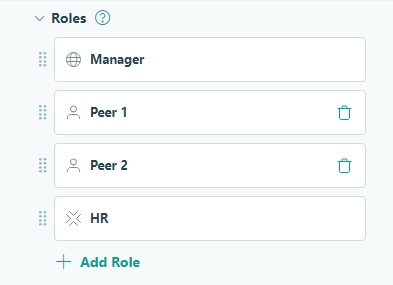
In our example, the section titled Manager Initiation is where the manager will enter their information, the information of the employee under review, and the name and contact information for the two peers that will be participating in the review. There are also sections that group fields together for each peer reviewing the employee.
The Field Settings for each section include:
- For the Manager Initiation section, set the Show This Field settings to For Roles > Manager + HR.

- For the Peer Feedback 1 section, set the Show This Field settings to For Roles > Peer 1 + HR.

- For the Peer Feedback 2 section, set the Show This Field settings to For Roles > Peer 2 + HR.

Statuses
The next step in building our 360 degree feedback form includes customizing statuses involved in the workflow. In the case of our feedback form, we want to create statuses that easily inform HR admins and managers of the state the feedback workflow is in.
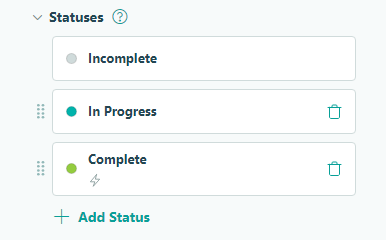
The statuses in our example include:
- Incomplete - Entries not yet submitted by managers will show as Incomplete.
- In Progress - The feedback form has been sent to an employee’s peers, and either one or none of their completed entries have been sent.
- Complete - The feedback form has been completed by both peers.
The Complete status has conditional logic assigned that moves an entry to this status when both signature fields have been filled out.

Actions & Email Notifications
Now that roles have been created and statuses customized, we can begin creating actions for our 360 degree feedback workflow:
- Submit - For managers to submit a new 360 degree feedback form, which begins the workflow.
- Send - For peers to send their feedback on the employee being reviewed back to the manager.
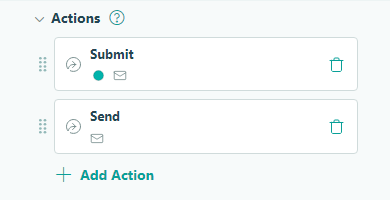
Below you’ll find the key Action Settings and email notifications that differentiate each action within our 360 degree feedback example. If you need more help, visit our Workflow Actions page.
Submit Action
Allow Action - Select ‘When’ to apply conditional logic to allow this action to be performed when the entry status is Incomplete. This will ensure an entry can only be initially submitted by a manager to begin the workflow.
Change Status To - Select ‘In Progress’ to automatically update an entry’s status to In Progress once the initial feedback review has been initiated by the manager.
Send Emails - Create two email notifications to be sent upon the Submit action being performed. These email notifications will be identical except for who they are sent to; use the Insert Field option to include the email address of each peer who will be sharing feedback about the employee under review.
You will also need to specify which peer workflow link to include in each email. Select either the Peer 1 or Peer 2 workflow link role to include the correct link with each peer’s email address.
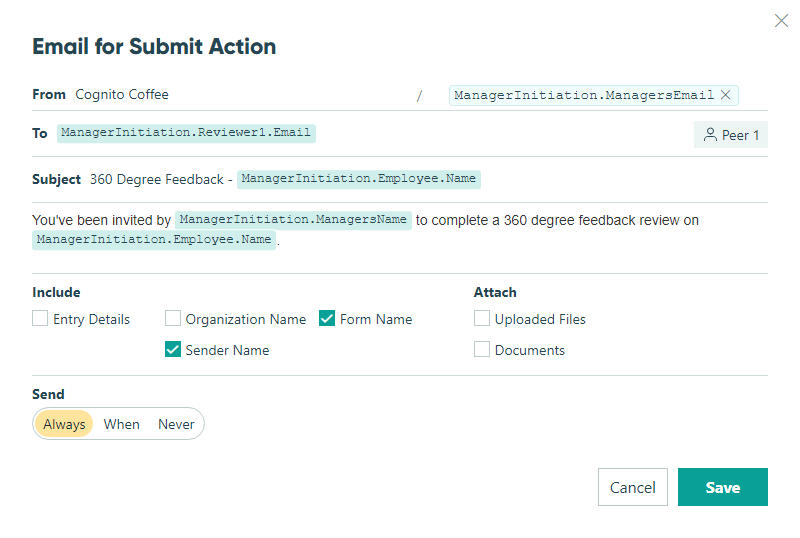
Send Action
Allow Action - Select ‘When’ to apply conditional logic to allow this action to be performed when the entry status is In Progress.
Send Emails - Create an email notification to be conditionally sent to the employee’s manager when both peer feedback signatures have been filled out, notifying them that the 360 degree feedback workflow is complete. Be sure to include an HR workflow link to enable the manager to access the admin view of the completed entry data.
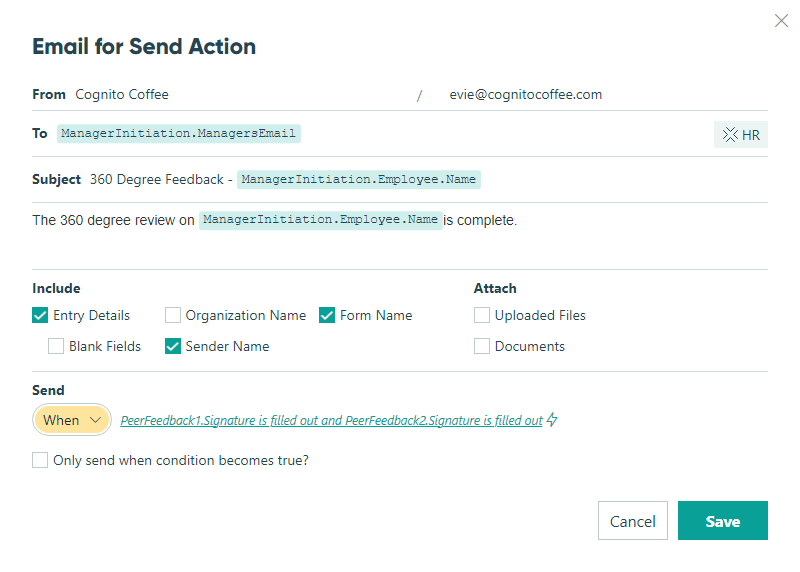

Form Read-Only
You’ll want to conditionally set your form to read-only to ensure that no changes are made to feedback entries once the form is filled out and signed by the employee’s peers. To do this, select ‘When’ under Form Read-Only and set conditions for when the role is either Peer 1 or Peer 2, and the status is complete.

Other Considerations
Once you’ve considered the above settings, it may be helpful to make other specific changes to your workflow. For example, making certain fields read-only or conditionally showing a field based on status can help make your workflow more efficient for your scenario.
For more help setting up your workflows, check out our Workflow help section.